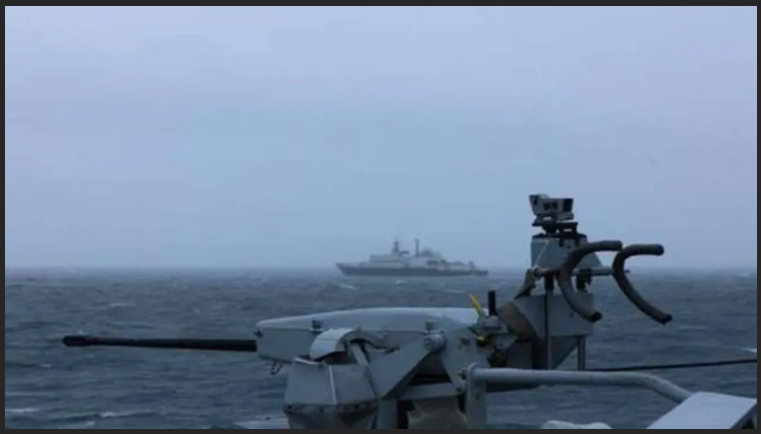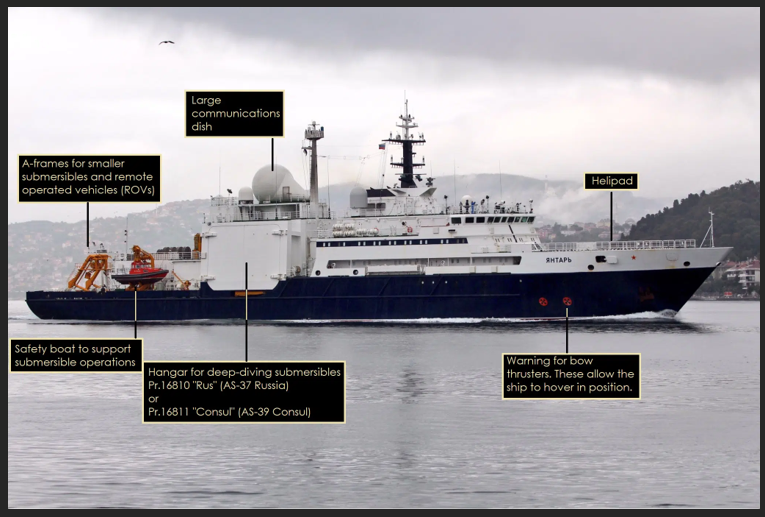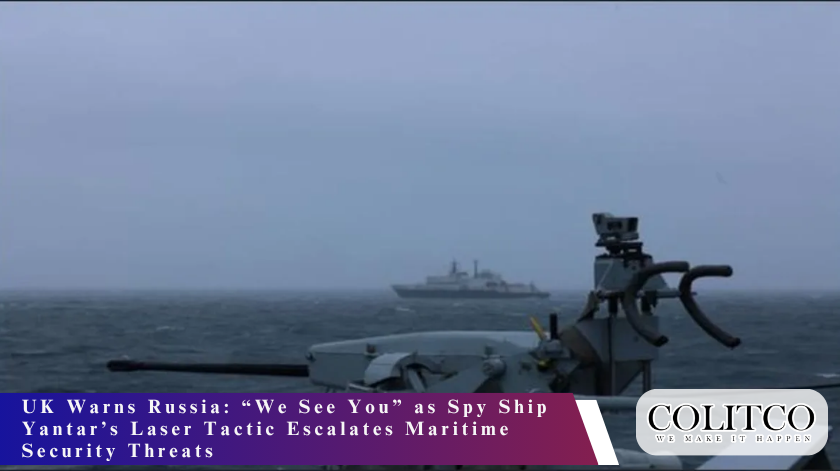The Russian spy ship Yantar has sparked international concern after entering waters near the United Kingdom. Defence Secretary John Healey reported the ship loitered close to northern Scotland. He highlighted that Yantar directed lasers at Royal Air Force pilots tracking the vessel. This incident marks the second time this year the vessel has deployed to UK waters. The situation raises serious questions about maritime security and Russian naval intentions.

The Yantar being monitored by a British vessel
Details of the Russian Spy Ship Yantar
The Yantar measures approximately 112 feet and operates under the Russian Defence Ministry’s Main Directorate of Deep-Sea Research. Officially designated as an oceanic research vessel, multiple nations classify it as a spy ship. Its primary capability includes deploying uncrewed underwater vehicles (UUVs). These UUVs can investigate the seabed and conduct activities such as mapping or potentially sabotaging undersea infrastructure. The ship’s repeated presence in strategic maritime areas draws significant attention given these capabilities.

Strategic Importance of Undersea Cables
Undersea cables transmit around 95% of the world’s international data traffic. The UK alone has about 60 such cables extending into the sea. The Yantar appears focused on gathering intelligence related to these vital communication lines. Mapping and surveilling undersea cables pose security risks, given these cables’ crucial role in global communications, financial transactions, and defence networks. Interference with this infrastructure could disrupt economies and national security.
Response from the United Kingdom
British authorities responded by deploying a Royal Navy frigate and RAF P-8 surveillance planes to monitor the Yantar. Secretary Healey stated, “We see you. We know what you’re doing.” The UK government adjusted the Navy’s rules of engagement to track the Yantar more closely. Officials warned that if the ship moved further south into territorial waters, military readiness measures would escalate. This stance reflects the UK’s intent to defend its maritime borders and critical infrastructure.
Russian Position and International Reactions
The Kremlin consistently claims the Yantar conducts legitimate maritime survey and research missions. However, Western nations remain sceptical, viewing the ship as a tool of Russian intelligence operations. NATO regards the vessel as a “nuisance ship,” but acknowledges its capabilities surpass some Russian naval assets. The incident adds tension to the existing geopolitical friction between Russia and Western countries, underscoring the broader strategic contest in maritime domains.
Historical Context of Yantar’s Operations
The Yantar’s presence near UK and NATO waters is not unprecedented. It frequently appears near critical oil and gas facilities in Norway and the UK. The vessel observed major naval exercises such as Germany’s live-fire drills off northern Norway in October 2025. Russian shadow fleets, including the Yantar, have come under scrutiny following sabotage incidents in the Baltic Sea. These actions demonstrate Russia’s ongoing interest in maritime intelligence and disruption operations.

Risks Posed by Spy Ship Activities
The deployment of laser devices against military pilots constitutes a direct threat to personnel safety and operational security. Such aggressive behaviour signals a readiness to challenge Western surveillance efforts. Gathering intelligence on underwater infrastructure could facilitate future sabotage or cyber disruption campaigns. The ability to interfere with undersea cables would have significant implications for national security, economic stability, and international communications networks.
Broader Security Implications for Australia and Allies
Australia shares concerns with allied nations about Russian maritime intelligence activities. The country’s reliance on undersea cables for international data flow makes it vulnerable to similar spying or sabotage threats. Close monitoring of Russian naval vessels operating in the Indo-Pacific region remains a priority for Australian defence authorities. Cooperation with allies like the UK and NATO enhances collective maritime domain awareness and response capabilities.
Technical Capabilities of Yantar and Similar Vessels
The Yantar operates as a mothership for advanced UUVs. These underwater drones can conduct detailed seabed surveys and interact with submerged infrastructure. The vessel’s tracking is aided by automatic identification systems, though it sometimes uses tracking manipulation to reduce detectability. Its technology and operational methods enable extensive intelligence gathering beyond simple maritime reconnaissance, making the ship a strategic asset in underwater espionage.
UK’s Military Preparedness and Future Actions
Updated rules of engagement empower the Royal Navy to engage more assertively if necessary. The UK maintains continuous surveillance of the Yantar whenever it enters sensitive maritime zones. Defence Secretary Healey’s message to Russia clearly states readiness to act if provocations escalate. Such preparedness signals a firm commitment to protecting national interests and deterring hostile maritime conduct.
Conclusion
The Russian spy ship Yantar’s repeated deployments near British and NATO waters constitute a significant security concern. Its activities demonstrate Russia’s strategic focus on undersea intelligence collection and potential sabotage capabilities. The UK’s robust military response and heightened readiness reflect the seriousness with which Western countries view the threat. The incident also highlights the importance of international cooperation to safeguard critical maritime infrastructure, a concern shared by Australia and its allies.












